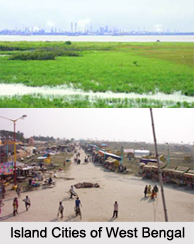 Island cities of West Bengal are connected with the railways and the roadways. These islands are located along the coastal line of Bay of Bengal. West Bengal is located in the eastern part of India on the Bay of Bengal. Northern part of West Bengal has hill stations and in the southern part has the islands, which attract the tourists.
Island cities of West Bengal are connected with the railways and the roadways. These islands are located along the coastal line of Bay of Bengal. West Bengal is located in the eastern part of India on the Bay of Bengal. Northern part of West Bengal has hill stations and in the southern part has the islands, which attract the tourists.
Lohachara Island
Lohachara Island is the tourism destination in West Bengal and it is the connecting point of Sundarbans national Park. It is located on the Hooghly River.
Nayachar
Nayachar is a special economic zone in West Bengal and it is the paradise to the fishermen. It is one of the trade centres for fishing near the Hugli River. Nayachar has emerged as the most logical option for a major chemical hub as the land belongs to the Government of West Bengal and the area being largely uninhabited.
Henry Island
Henry Island is one of the tourism destinations in West Bengal and it is very near to Bakkhali Beach.
Sagar Island
Sagar Island which is known as Gangasagar lies in the part of Sunderban administration. It is the town known as the pilgrimage tourism destination reachable by train via Kakdwip. Gangasagar fair and pilgrimage is held annually on Sagar Island"s southern tip, where the Ganga River enters the Bay of Bengal. Kapil Muni Temple is also located here. Every year on the day of Makar Sankranti that is the Georgian calendar of 14th January, thousands of Hindus gathers to take a holy dip at the confluence of river Ganges and Bay of Bengal and offer prayers in the Kapil Muni Temple. The island is large, with an area of 224.3 square kilometers, lying between 21 degree 36 minutes to 21 degree 56 minutes north latitude and 88 degree 2 minutes to 88 degree 11 minutes east latitude. It has 43 villages and a population of over 160,000. The Gangasagar pilgrimage and fair is the second largest congregation of mankind after the triennial ritual bathing of Kumbha Mela that is held in Allahabad in Uttar Pradesh near the confluence of Ganga River, Yumuna River and the Sarawasti River.



















